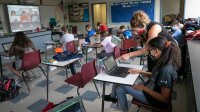What Educators Are Learning During the Pandemic
Many school leaders and teachers are focusing on whole child education, an idea that seems likely to grow in prominence in the future.
Your content has been saved!
Go to My Saved Content.In 2020, educators have faced pandemic-driven remote schooling and also widespread inequities in education and society that have been made obvious by the virus. As schools were forced to switch to distance learning overnight, huge disparities became undeniable: We witnessed children, especially children of color, facing poverty, hunger, mental health issues, lack of computers and internet access, and consequent fears of falling behind. The pandemic led educators to confront these inequities and redouble their ongoing efforts to meet not only the academic but also the physical and social-emotional needs of students.
What we have learned enables us to imagine a more equitable education. I have recently been speaking with educators and students in California, and I’ve learned of many innovative practices that can continue when all students and teachers are back in their classrooms full-time. I will focus on the power of relationships, innovative curriculum, and wraparound services. While the idea of whole-child education isn’t new, more educators now recognize the necessity to embrace it.
Strong Relationships Are the Heart of Learning
With distance and hybrid learning, educators work harder to forge relationships with and among students. Many have found innovative ways to build trust and create identity safety, where each student feels welcomed, accepted, and valued. These efforts are happening all over the country; below are a few examples I’ve learned of in my work.
One teacher told me, “I typically start my Zoom sessions 10 minutes prior to the start of class. When students enter, I engage in casual conversations, asking about their weekend, what’s ahead in the week, and how they’re doing.”
A district superintendent reported that over half their teachers were providing individualized tutoring, and many schools have enlisted retired teachers and other volunteers to assist in similar efforts. For example, a volunteer in Berkeley, California, supports a kindergarten teacher five days a week by offering one-to-one and small group tutoring, an invaluable contribution to students’ confidence and sense of belonging.
Educators have also strengthened collegial relationships with peers. A Berkeley teacher invited fellow second-grade teachers to a monthly Zoom to share best practices in distance learning as well as what was and wasn’t working with virtual teaching. And a similar weekly support group for new administrators became a lifeline for them.
Students have stepped up too. High school students Nelson Mu and Andrew Lu formed Yapa Kids, a network of older students who teach free classes in math, science, Mandarin, Spanish, and the arts to younger ones. Their website mushroomed, with 500 teens teaching 3,500 children nationwide.
Blended, Personalized, and Project-Based Learning
Many educators are improving students’ skills in research, video production, and website design. Using Facetime, a 9-year-old English learner who aspires to be a marine biologist interviewed a shark researcher in Australia, an oceanographer in New York, and a marine biologist in Washington DC. A middle schooler who was assigned a project to demonstrate the cultural influences that helped to shape him—languages, holidays, beliefs, and values—interviewed an older relative and created a website about the impact of his Jewish background, deepening his understanding of his own culture.
A drama teacher told my team, “Creating digital media such as songs, poems, and podcasts is something I plan to continue when we return to in-person instruction. Utilizing platforms such as Soundtrap has helped me create virtual connections and allowed for creative expression. Partnering with national nonprofits like Little Kids Rock has shown me that music as a means for storytelling and building community can engage students in fun and inspiring ways.”
In a partnership with the musical instrument company Fender, LAUSD distributed about 1,000 guitars, ukuleles, and basses to middle school students for online lessons, and when it is safe to do so, these musicians will perform together at the Hollywood Bowl.
Wraparound Services and a Focus on Well-Being
The pandemic forced school leaders and teachers to reach out to their communities in ways they had never done before. Many families did not have computers or internet access, and some parents required a translator to learn how to access Zoom and Google Classroom, so school districts created multilingual courses to help parents learn the technology and strategies to support their children at home. The AFT provided a resource for parents of children with ADHD for developing a schedule for learning at home.
In the full-service community model, schools partner with local organizations to offer an array of services. When the pandemic struck, full-service community schools moved into action quickly. The Oakland USD Community School Department, for example, identified urgent family needs, provided food, made referrals for housing and health care, and monitored attendance. In Brockton, Massachusetts, a community hit hard by Covid-19, a team of multilingual volunteers are staffing a call center to support families, connecting parents and caregivers to counseling, nurses, and an array of services. Many other districts are following suit.
Going forward, educators can aspire to a new paradigm: Using what we’ve learned during the pandemic about the power of relationships, innovative instructional models, and community partnerships, our schools can become more equitable for all students.
I’d like to thank Dr. Susan Charles and Donald Cox for their help with this article.
